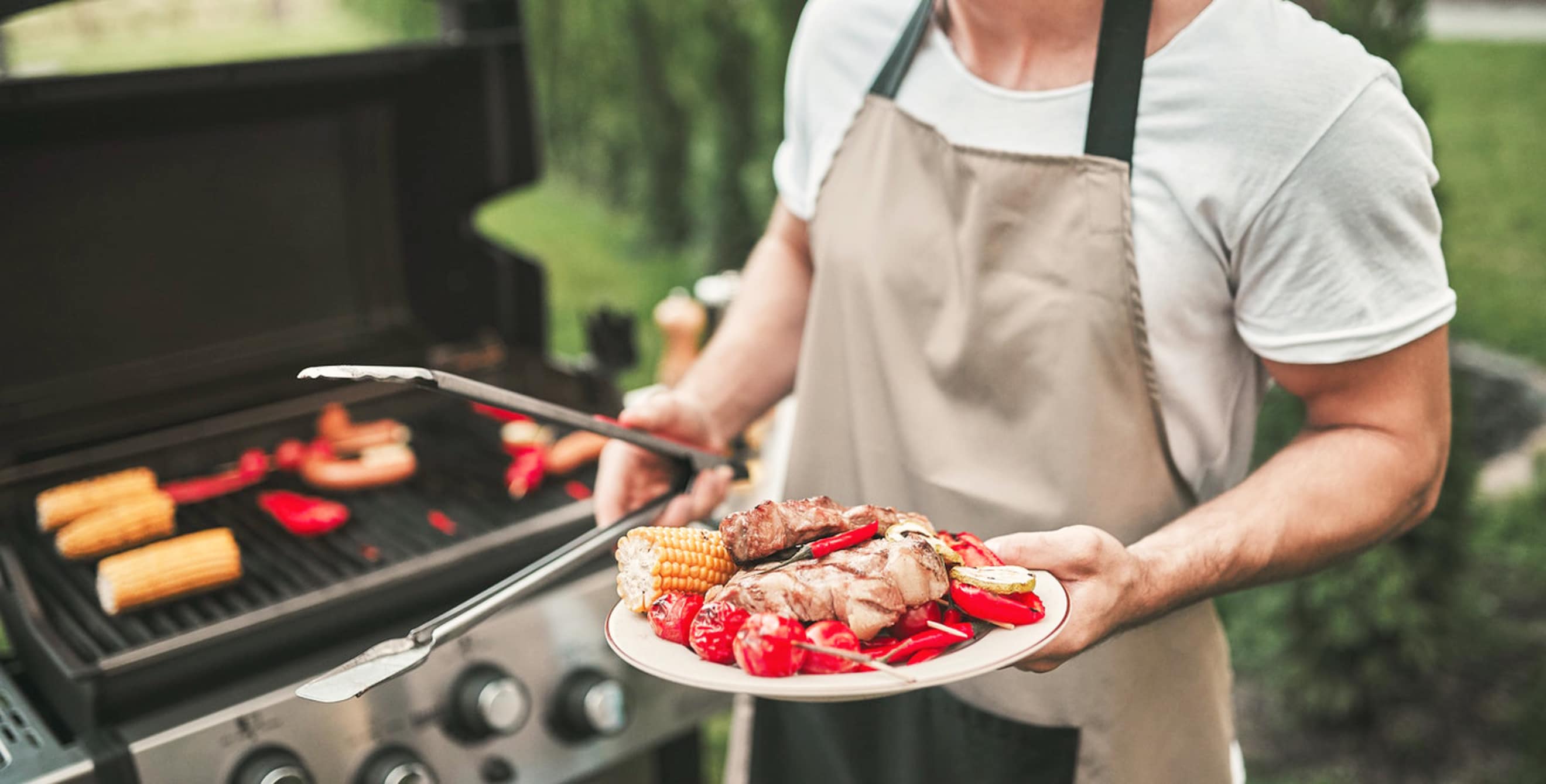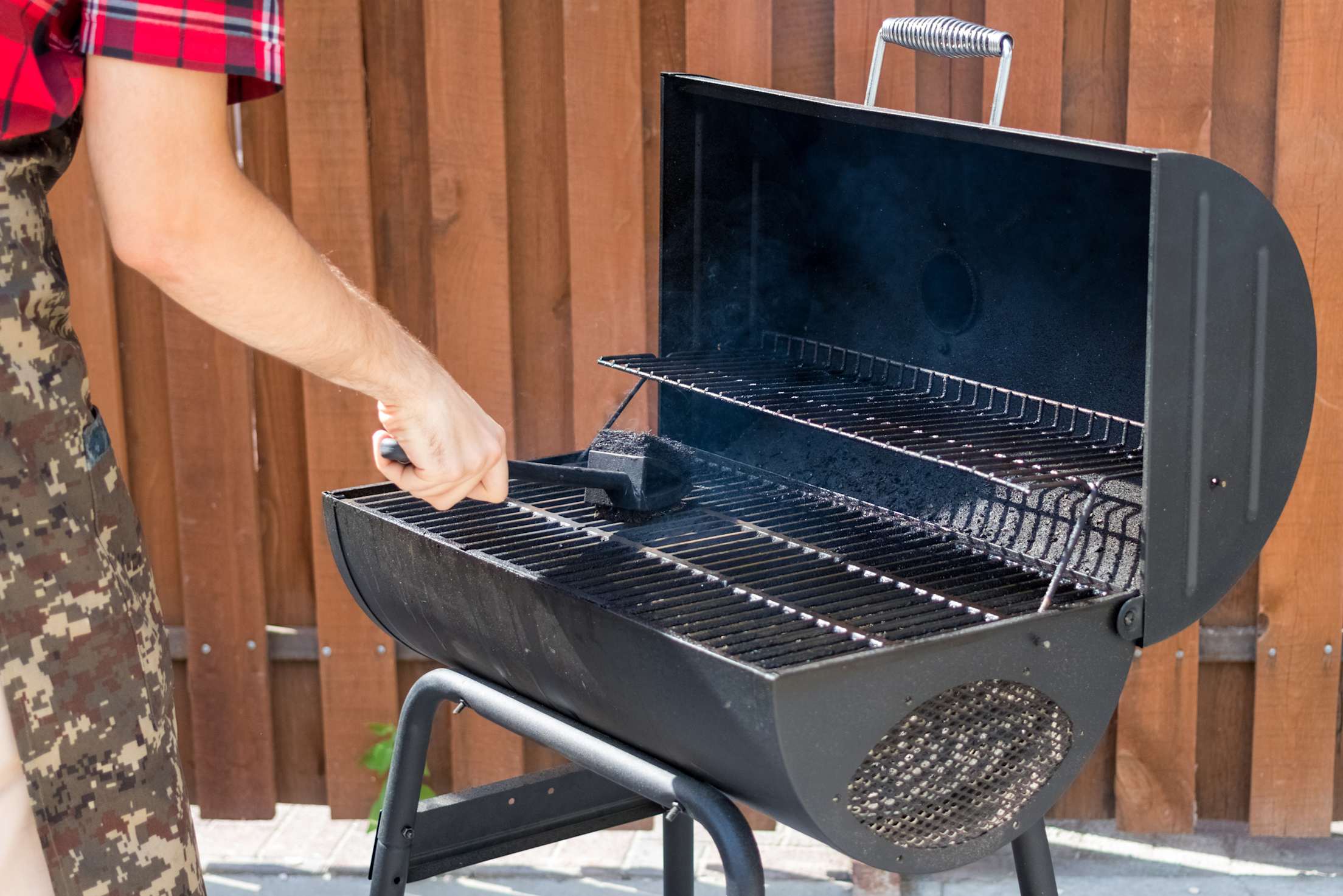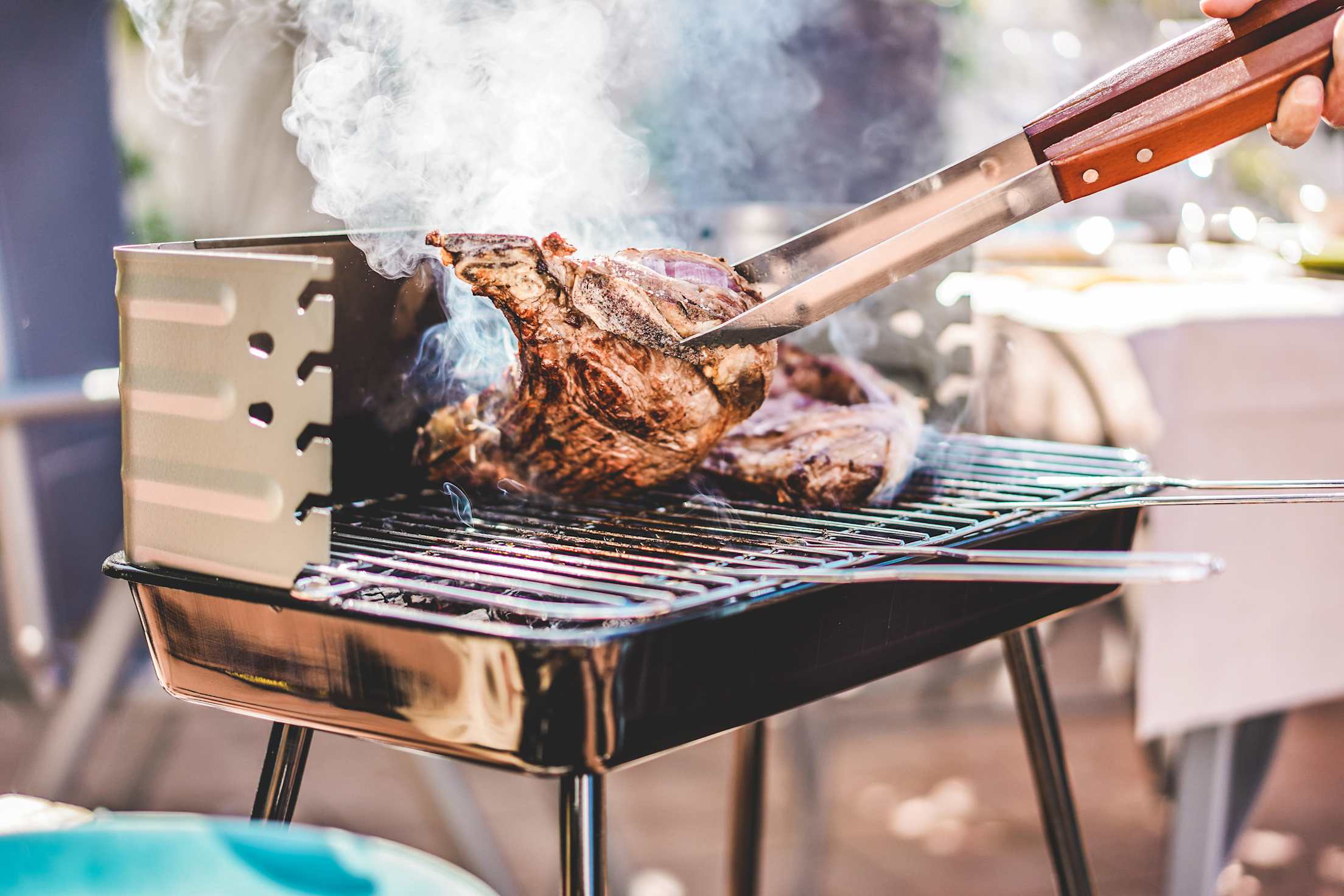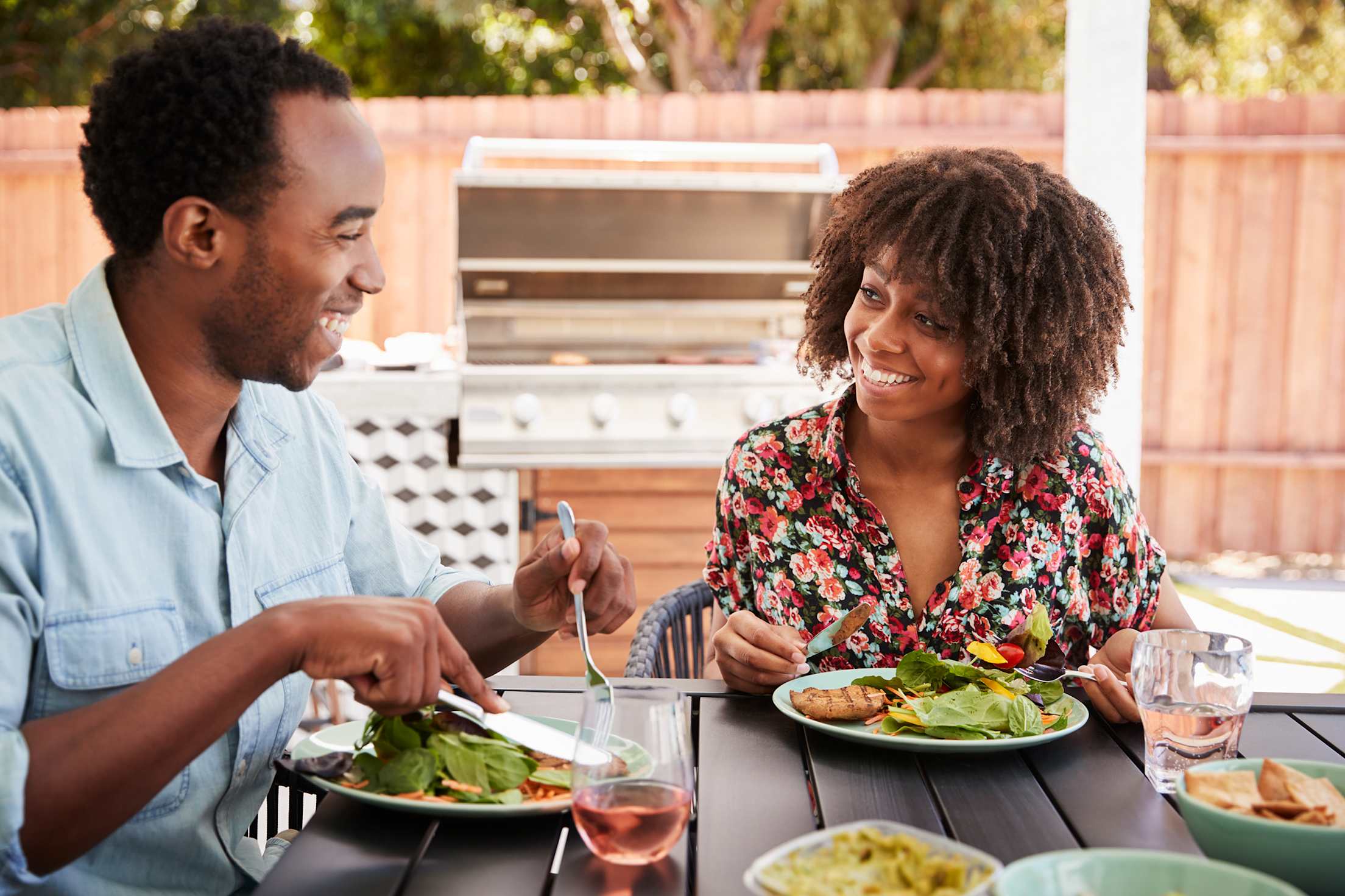
6 Tips for a Safe Barbecue
As you light up the grill this summer, here’s how to avoid dangers from fire to food poisoning.

There’s nothing like popping open the lid to your barbecue to reveal vegetables, burgers, or fish grilled to perfection. But don’t neglect safety as you delight in this warm weather activity.
When grilling goes wrong, it can lead to home fires, property damage, and carbon monoxide poisoning. A study from the National Fire Protection Association found that gas grills are involved in an average of more than 9,000 home fires each year. Plus, eating outdoors—especially when temperatures are high—ups the potential for food poisoning. (We’re looking at you, potato salad.)
Before you tie on your apron and whip out your tongs, take a look at these important guidelines to help keep you, your loved ones, and your home free from harm.
1. Put your grill in a safe spot.
The best spot for your barbecue or smoker is a level surface far from anything flammable, such as low-hanging tree branches or nearby shrubbery, the deck railing, or the siding of your home or garage. “Households should always place grills at least 10 feet from their home,” says Sharon Cooksey, a fire safety educator with Kidde. This protects the home’s exterior and helps prevent carbon monoxide from getting inside, she says. Grills should never be used indoors (not even in the garage with the door open) due to the risk of both fire and carbon monoxide poisoning, warns Cooksey.
Take note of city and county regulations when you choose a location for your grill, too. In the Bay Area, for instance, barbecuing with charcoal is discouraged on Spare the Air days when air quality is low, but using a gas or propane grill is fine. In California, Arizona, and many other states and cities, any BBQ or grill that uses open flames can’t be used on balconies, patios, and so on unless there’s an automatic sprinkler system in place. Your homeowner’s association, condo board, or landlord may also have rules about grilling.
2. Get familiar with your grill.
Read the manufacturer’s instructions before firing up the grill, then follow them every time you use it. Check for recalls at the start of grilling season (or sign up for email updates) on the Consumer Product Safety Commission website.

3. Inspect and clean your grill.
At the start of grilling season, inspect your BBQ closely. Then, clean it thoroughly after every use. It’s not just gross if you don’t clean the grill after cooking—it’s dangerous. In more than a quarter of fires caused by grilling, the appliance wasn’t cleaned, according to the National Fire Protection Association.
Gas Grill Maintenance and Cleaning
- Inspect the lines. “Grill owners should check grill hoses for leaks and clear any blockages,” Cooksey says—cracks or abrasions are a bad sign. At the start of the season, place soapy water on all connections. Keep the control knobs off, and turn on the gas—if you spot bubbles, there’s a leak.
- Check for blockage. Both food and animal droppings can cause blockage in venturi tubes, which connect the gas to the burners. Remove the tubes and use a wire (from a paper clip) or pipe cleaner to clean them out, recommends the Insurance Information Institute.
- Burn off food remnants. Keep the gas grill on high for a few minutes after cooking, then scrape the cooking grates with a wire brush.
- Clean routinely. Use a wire brush to clear debris from gas ports, which can be a fire hazard. Plus, remove any grease found in the grease tray. “Ensuring your grill is clean of heavy grease or fat buildup can help prevent a fire,” says Cooksey.
Charcoal Grill Maintenance and Cleaning
- Clean the grates every time. While it’s still hot from cooking, use a wire brush to scrub the grates to remove grease and food remnants. (You can also crumple up aluminum foil, then use long tongs to scrape it across the grate.) Next, use a paper towel to apply a tiny amount of oil to the grates—this prevents food from sticking the next time you light it up.
- Empty the ash catcher. Once the grill is completely clean and cool, remove and dispose of ashes and charcoal from the ash receptacle.
- Occasionally scrape the inside. Remove grates and scrape hardened grease and gunk stuck to the sides. Clean the inside of the lid, too.
Smart tip: Keep an eye on your grill brush; once it shows signs of wear or the bristles fall out, replace it so you won’t wind up with stray bits of metal in your food.

4. Follow grill safety guidelines.
Since you’re dealing with flames, it’s wise to stay alert and focused while grilling, says Cooksey. Make sure to follow these safety guidelines:
- Never leave the grill unattended once it’s lit.
- Light it correctly. With charcoal grills, never use gasoline in place of charcoal lighter fluids, notes Cooksey. And don’t add more lighter fluid once the fire is sparked. “The flames can ignite the vapors and travel up to the can, causing an explosion,” Cooksey says. Always open the lid to a gas grill before turning it on, she says—doing so prevents gas from building up inside and exploding when lit.
- Keep an extinguisher nearby. Since a grease fire is common with grills, you need to opt for a fire extinguisher in place of water, which can make the fire worse, Cooksey notes. Familiarize yourself with the PASS method, so you feel confident using the fire extinguisher, Cooksey says: Pull the tab, Aim low toward the base of the fire, Squeeze the handle, and Sweep side to side.
- Use the appropriate tools. Opt for long-handled grilling tools so that you won’t get too close to the heat, and use flame-resistant mitts instead of your usual pot holders.
- Dress for the task. That means no loose clothing or dangling apron strings that could ignite.
- Keep your grilling area kid- and pet-free. “To do this, keep a three-foot ring of safety around the grill while you’re cooking,” Cooksey suggests.

5. Avoid food poisoning.
You may be eating outside—a long, leisurely meal—but that doesn’t mean food safety principles should fall by the wayside. Here’s what to keep in mind:
- Wash your hands. Clean them before touching food and again after handling raw meat.
- Take care with marinades. If you’re marinating foods, do so in the fridge—not outside or on the countertop. Discard any leftover marinade that’s been in contact with raw meat.
- Opt for fresh serving platters and cutlery. If you had a plate with raw burgers on it, place it in the sink or dishwasher after putting those burgers on the grill.
- Make sure food is cooked properly. A food thermometer can help you know when meat is fully cooked and safe to eat. Aim for 160°F for hamburgers, 165°F for poultry and hot dogs, and 145°F for fish, per the U.S. Food and Drug Administration.
- Keep hot foods hot and cold foods cold. Avoid the danger zone—bacteria flourish when the temperature is between 40°F and 140°F. Once you’ve dished up the meal, eat food within two hours (or place it in the refrigerator). When the temperature is above 90°F, that window shrinks to one hour.
6. Store it properly.
Always wait until the grill is completely cooled down before covering or moving it. “For gas grills, homeowners should always store propane tanks outside and away from the house with valves turned off,” Cooksey says.
Unlit charcoal can be stored inside, but do not bring a grill with freshly used coals inside until the charcoal is completely extinguished, per the Consumer Product Safety Commission. If the coals are cool to the touch, you’re safe to bring the grill inside. Do not dispose of charcoals until they are completely cool.
Whether you own or rent your home, protect your personal property with AAA Insurance.